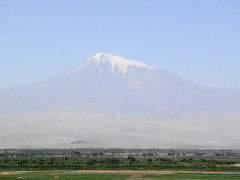When dawn broke over Yerevan last Friday morning, the city came into full view for the first time. The center of the city sits like a wide stage in a giant amphitheater—open towards the west where Mount Ararat rises. Mount Ararat, where Noah is said to have waited out the flood in Genesis, has a central place in the heart of the Armenian nation. It is the tallest mountain in the land where Armenians have lived for millennia, and it rises above the Anatolian plane of Asia Minor with a drama surpassed by few other mountains in the world. There is a year-round snowcap at the peak; the Armenians call it the bridal veil. The mountain's rise from the fields below is so sudden and steep that the veil looks like a cloud sitting above the summer haze.
That Ararat now sits across the Turkish border makes this mountain also a symbol for the lost culture of Western Armenia. With few exceptions, Turkey prohibits tourists from traveling to the mountain. Cut away from the nation's boundaries, the mountain is as unreachable and omnipresent as a phantom pain, standing in for the suffering of Armenia's last 120 years. The poetry, music, and culture of the past invoke its greatness, while the current situation reminds the Armenian nation of its lost glories.
We visit Ararat tomorrow.
skip to main |
skip to sidebar

|
tags
Blog Archive
- September 2011 (18)
- August 2011 (20)
- July 2011 (27)
- June 2011 (24)
- May 2011 (39)
- April 2011 (26)
- March 2011 (47)
- February 2011 (28)
- January 2011 (14)
- December 2010 (25)
- November 2010 (13)
- October 2010 (23)
- September 2010 (12)
- August 2010 (6)
- July 2010 (12)
- June 2010 (10)
- May 2010 (13)
- April 2010 (30)
- March 2010 (30)
- February 2010 (32)
- January 2010 (35)
- December 2009 (27)
- November 2009 (24)
- October 2009 (31)
- September 2009 (25)
- August 2009 (36)
- July 2009 (31)
- June 2009 (43)
- May 2009 (25)
- April 2009 (37)
- March 2009 (28)
- February 2009 (21)
- January 2009 (22)
- December 2008 (16)
- November 2008 (10)
- October 2008 (15)
- September 2008 (14)
- August 2008 (5)
- July 2008 (16)
- June 2008 (17)
- May 2008 (12)
- April 2008 (15)
- March 2008 (8)
- February 2008 (10)
- January 2008 (8)
- December 2007 (12)
- November 2007 (10)
- October 2007 (13)
- September 2007 (13)
- August 2007 (7)
- July 2007 (17)
- June 2007 (12)
- May 2007 (24)
- April 2007 (18)
- March 2007 (16)
- February 2007 (9)
- January 2007 (18)
- December 2006 (11)
- November 2006 (8)
- October 2006 (15)
- September 2006 (16)
- August 2006 (11)
- July 2006 (14)
- June 2006 (19)
- May 2006 (13)
- April 2006 (6)
- March 2006 (14)
- February 2006 (11)
- January 2006 (15)
- December 2005 (9)
- November 2005 (11)
- October 2005 (12)
- September 2005 (10)
- August 2005 (29)
- July 2005 (13)
- June 2005 (20)
- May 2005 (22)
- April 2005 (30)
- March 2005 (21)
- February 2005 (3)
